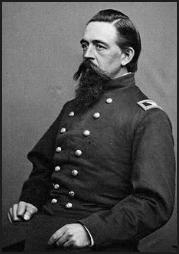William H. Christian facts for kids
Quick facts for kids
William Henry Christian
|
|
|---|---|
 |
|
| Born | April 9, 1825 Utica, New York, United States |
| Died | May 8, 1887 (aged 62) Utica, New York, United States |
| Buried |
Forest Lawn Cemetery, Utica, New York, United States
|
| Allegiance | |
| Branch | |
| Years of service | 1846 – 1862 |
| Rank | |
| Commands held | 26th New York Infantry Regiment |
| Battles/wars | Mexican–American War American Civil War |
William "Bill" Henry Christian was an American soldier who became a Brevet Brigadier General. He served in the American Civil War and led the 26th New York Infantry Regiment. His regiment took part in important battles, including the Battle of Antietam.
Contents
Biography
Early Life and Military Start
William Christian was born on April 9, 1825, in Utica, New York. He first joined the military during the Mexican–American War in 1846. He trained for two months at Governors Island before moving to San Francisco. He did not see active fighting in the war. By the end of the war, he was promoted to First Sergeant.
After the war, he stayed in California because of the California Gold Rush. He worked as a teacher there. In 1856, he returned to New York. He became a city surveyor in Utica. Before the Civil War, he rejoined the New York Militia as a drillmaster, teaching soldiers how to march and fight.
American Civil War Service
When the American Civil War began, Christian went to Albany. He asked Governor Edwin D. Morgan for permission to create a volunteer regiment. Governor Morgan thought Christian was a good choice because he was a veteran. Christian quickly gathered over 1,000 men to form the 26th New York Infantry Regiment. He became their first commander on May 21, 1861.
Christian was known for being a strict leader. This helped his soldiers become very well-trained. People said his training showed "military skill and energy." His regiment was called "the best-drilled volunteer regiment."
First Battles and Challenges
The 26th New York arrived in Washington, D.C. on April 22, 1861. They settled at Meridian Hill. Their first major fight was at the First Battle of Bull Run. The regiment helped cover the retreat of Union soldiers. Even President Abraham Lincoln praised their actions.
After this battle, Christian and his regiment did not see much action for six months. They then joined the new Army of the Potomac. They were part of Henry Warner Slocum's brigade. Christian and 350 men were sent to Pohick Church on October 21, 1861. Their mission was to capture Confederate cavalry. However, the mission did not go as planned.
After this event, Christian was transferred to Fort Lyon. He married Mary Timmerman on November 6, 1861. They stayed at the fort until May 1862. The 26th New York was then moved to Irvin McDowell's III Corps. This corps was part of John Pope's new Army of Virginia. The regiment moved to camps near Falmouth and then Manassas. They joined Pope's army to face Lee's Army of Northern Virginia.
Second Battle of Bull Run
The 26th New York fought in the Second Battle of Bull Run. They were part of the 2nd Brigade of James B. Ricketts's 2nd Division. During the battle, Christian was not with his men. He was found resting under a tree. He was suffering from heatstroke and poison ivy. He recovered and later took command of the brigade when Brigadier General Zealous Bates Tower was wounded. The brigade then moved back to Centreville, Virginia.
Battle of Antietam
Christian also took part in the Battle of South Mountain and the Battle of Chantilly. He played a supporting role in these battles. Later, Christian and his brigade marched across Antietam Creek. They began a small fight with the Confederate lines.
During the early morning of the Battle of Antietam, Christian's brigade was supposed to support other brigades. They faced heavy Confederate artillery fire in the North Woods. Christian moved to the safety of the East Woods, leaving his men without a direct leader.
While the battle was difficult, Christian tried to drill his men. But Confederate artillery fire was very strong. To escape the dangerous situation, Christian ordered his men to retreat. At one point, Richard Coulter asked Christian for help. Christian did not follow him.
Christian then left the battle scene on his horse. He abandoned his brigade and declared the battle was lost. His men were confused and left without a leader. Colonel Peter Lyle had to take command of Christian's remaining men. These soldiers then fought bravely for the rest of the battle.
Christian was later seen shaking under a tree behind the lines by Brigadier General Truman Seymour. That evening, General Ricketts told Christian he must resign or face a court-martial. Christian chose to resign. He claimed "important business" required him to return to Utica. He resigned two days later.
Life After the War
When Christian returned home, he gave a different reason for leaving the army. He said he left because of problems with other officers. However, the truth about his actions at Antietam eventually became known.
After the war, Christian tried to get back into military service. He even offered to serve without pay, but he was not given a command. On December 8, 1868, President Andrew Johnson nominated Christian for a special promotion. He was promoted to brevet brigadier general, which is an honorary rank.
William Christian passed away on May 8, 1887. He was buried at Forest Lawn Cemetery in Utica.

